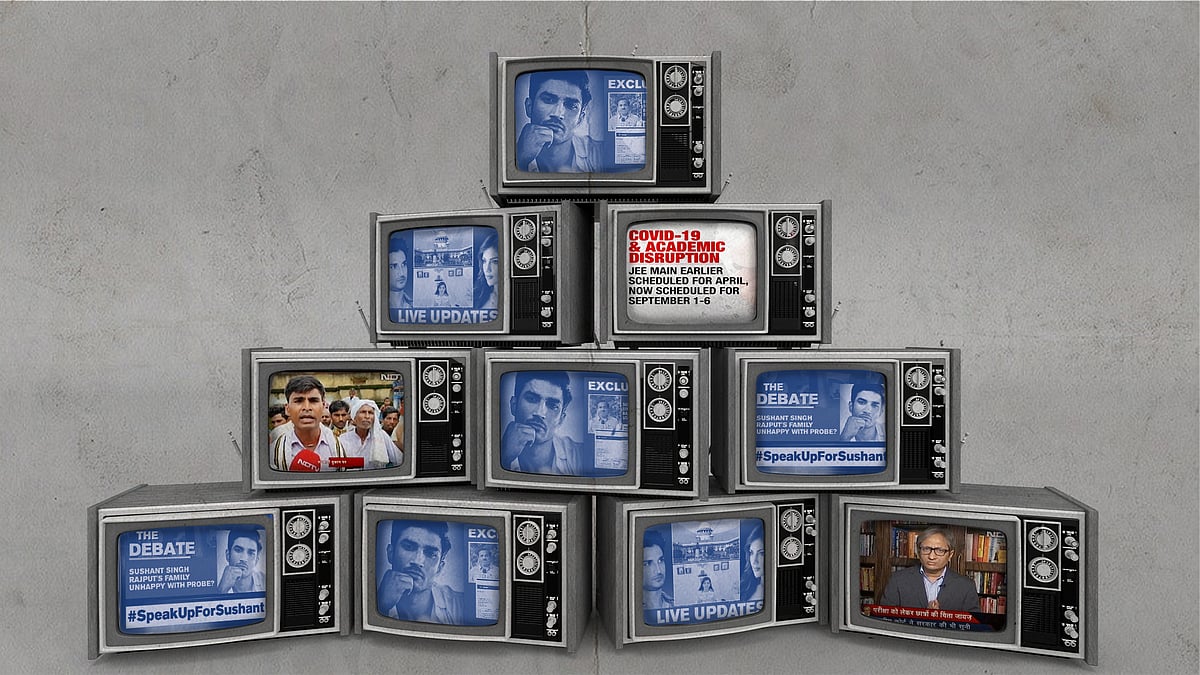Some primetime news channels spent as much as 70% of their time on Sushant Singh Rajput, and less than 2% on the economy
Data science tools confirm that channels didn’t care as much about Covid, China, or the recession.
One of the main duties of the news media is speaking truth to power. But in the present time, most news channels have become stooges of power, peddling news stories supportive of the incumbent government and deflecting attention from unfavourable news.
A recent example is the TV coverage of the tragic death of actor Sushant Singh Rajput. Coverage started with "suicide due to depression" and led to a reasonable discussion on the neglect of mental health issues in our country. However, as this topic possibly did not result in huge TRPs, the coverage soon shifted to a web of conspiracy theories, including the role of Rajput’s girlfriend, actor Rhea Chakraborty, in his death.
Using tools of data science, we showed in Figure 1 that some primetime news channels spent as much as 70 percent of their time on Rajput’s death prior to Chakraborty’s arrest on September 8. In the weeks preceding her arrest, all one would hear on these channels was how Chakraborty was a “drug addict” using Rajput for financial gain, and how she used “black magic” to induce Rajput to take drugs.

For weeks, it seemed like there was no other major news story apart from Rajput’s death. This is particularly striking when you think of the times we live in, with thousands dying of Covid, a looming war with China, and an economic recession in the offing.
Our methodology used videos of major news networks uploaded on their YouTube channels between May 01 to September 10, 2020. We selected all videos that mentioned Chakraborty and Rajput’s names, both in English and in Hindi, in their titles. Adding the total duration of all these videos covering Rajput’s death, and then dividing by the total duration of all videos uploaded on YouTube that week, gave us a reasonable estimate of the total time spent on a specific news story by a news channel per week.
We solely looked at the relative amount of time given to a news story, without focusing on whether the coverage was positive or negative.
As expected, the media coverage picked up whenever a major news story breaks, such as June 14, which was the day of Rajput’s death, or July 25, when his parents filed an FIR against Chakraborty. But the time spent by various news channels on the case over the months is very different. Republic TV, Times Now, and Aaj Tak spent 50-70 per cent of their time on this topic in August. ABP News also spent around 40-50 per cent of their time on Rajput’s death. Coverage on Zee News remained around 20 per cent but went up to 50 per cent in the last week of August which might be attributed to the airing of Chakraborty’s interview on NDTV on August 28.
In contrast, the percentage of time spent by the same news channels barring NDTV on the economy, GDP, or jobs during the same period was less than two per cent, as shown in Figure 2. NDTV’s stats on coverage of news related to the economy is comparatively better.

On September 2, the news broke that India’s economy had contracted by 24 per cent between April and June, 2020. However, Republic TV, Times Now, and, Aaj Tak spent less than five per cent of their time on the economy and continued to focus on Rajput’s death and Chakraborty’s involvement. NDTV spent almost 12 per cent of its time on GDP in the first week of September.
When this much coverage is given to a single, “inconsequential” news story, you have to question the motivation and purpose of news channels.
Our code is publicly available here.
Ankit Kumar is a condensed matter physicist based in North Carolina, USA. Anshu Gupta is a postdoctoral researcher in Astronomy at UNSW, Sydney, Australia.
 Has primetime TV covered anything beyond Sushant Singh Rajput lately? Sort of
Has primetime TV covered anything beyond Sushant Singh Rajput lately? Sort of
